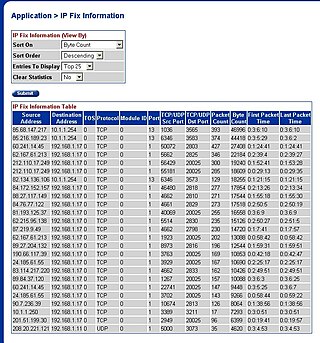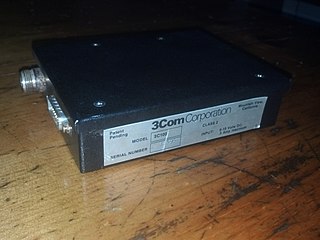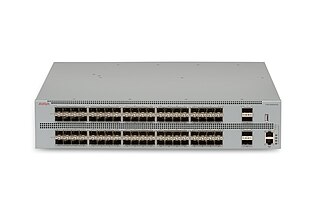
In computer networking, Fast Ethernet physical layers carry traffic at the nominal rate of 100 Mbit/s. The prior Ethernet speed was 10 Mbit/s. Of the Fast Ethernet physical layers, 100BASE-TX is by far the most common.

In computer networking, Gigabit Ethernet is the term applied to transmitting Ethernet frames at a rate of a gigabit per second. The most popular variant, 1000BASE-T, is defined by the IEEE 802.3ab standard. It came into use in 1999, and has replaced Fast Ethernet in wired local networks due to its considerable speed improvement over Fast Ethernet, as well as its use of cables and equipment that are widely available, economical, and similar to previous standards.
XENPAK is a multisource agreement (MSA), instigated by Agilent Technologies and Agere Systems, that defines a fiber-optic or wired transceiver module which conforms to the 10 Gigabit Ethernet (10GbE) standard of the Institute of Electrical and Electronics Engineers (IEEE) 802.3 working group. The MSA group received input from both transceiver and equipment manufacturers during the definition process. XENPAK has been replaced by more compact devices providing the same functionality.

Small Form-factor Pluggable (SFP) is a compact, hot-pluggable network interface module format used for both telecommunication and data communications applications. An SFP interface on networking hardware is a modular slot for a media-specific transceiver, such as for a fiber-optic cable or a copper cable. The advantage of using SFPs compared to fixed interfaces is that individual ports can be equipped with different types of transceivers as required.

The physical-layer specifications of the Ethernet family of computer network standards are published by the Institute of Electrical and Electronics Engineers (IEEE), which defines the electrical or optical properties and the transfer speed of the physical connection between a device and the network or between network devices. It is complemented by the MAC layer and the logical link layer.
40 Gigabit Ethernet (40GbE) and 100 Gigabit Ethernet (100GbE) are groups of computer networking technologies for transmitting Ethernet frames at rates of 40 and 100 gigabits per second (Gbit/s), respectively. These technologies offer significantly higher speeds than 10 Gigabit Ethernet. The technology was first defined by the IEEE 802.3ba-2010 standard and later by the 802.3bg-2011, 802.3bj-2014, 802.3bm-2015, and 802.3cd-2018 standards.
The current portfolio of PowerConnect switches are now being offered as part of the Dell Networking brand: information on this page is an overview of all current and past PowerConnect switches as per August 2013, but any updates on current portfolio will be detailed on the Dell Networking page.

The Ethernet Routing Switch 5500 Series or is a series of stackable, Layer 3 switches used in computer networking. The ERS 5000 was originally designed by Nortel and is now manufactured by Avaya. Up to 8 ERS 5000 Series Switches may be stacked in a 640 Gbit/s fast stacking configuration. This Switch was used as the access layer device for the 2010 Winter Olympics games. The 817 Access Switches supported 8782 Voice-over-IP telephones.
HP ProCurve was the name of the networking division of Hewlett-Packard from 1998 to 2010 and associated with the products that it sold. The name of the division was changed to HP Networking in September 2010. Please use HP Networking Products for an actual list of products.
The Cisco Nexus series switches are modular and fixed port network switches designed for the data center. Cisco Systems introduced the Nexus Series of switches on January 28, 2008. The first chassis in the Nexus 7000 family is a 10-slot chassis with two supervisor engine slots and eight I/O module slots at the front, as well as five crossbar switch fabric modules at the rear. Beside the Nexus 7000 there are also other models in the Nexus range.

On 12 April 2010, Hewlett-Packard completed a previously announced acquisition of 3Com. Following the HP acquisition, 3Com was fully absorbed by HP and no longer exists as a separate entity. The article below explains the portfolio at the time of acquisition.

10 Gigabit Ethernet is a group of computer networking technologies for transmitting Ethernet frames at a rate of 10 gigabits per second. It was first defined by the IEEE 802.3ae-2002 standard. Unlike previous Ethernet standards, 10 Gigabit Ethernet defines only full-duplex point-to-point links which are generally connected by network switches; shared-medium CSMA/CD operation has not been carried over from the previous generations Ethernet standards so half-duplex operation and repeater hubs do not exist in 10GbE.

The Dell blade server products are built around their M1000e enclosure that can hold their server blades, an embedded EqualLogic iSCSI storage area network and I/O modules including Ethernet, Fibre Channel and InfiniBand switches.
Avaya Virtual Services Platform 7000 Series or VSP 7000 is a set standalone/stackable switches, used in enterprise data networks, and data centers, manufactured by Avaya. This product is primarily offered to satisfy the Top-of-Rack (ToR) role for server farms and virtualized data centers. It supports Avaya's extended Shortest Path Bridging (SPB) implementation "Fabric Connect", and is future-ready for Edge Virtual Bridging (EVB) – IEEE 802.1Qbg, and Fiber Channel over Ethernet (FCoE). The system incorporates fifth generation application-specific integrated circuit (ASIC) chips with redundant and hot-swappable power supplies, fans, and expansion modules. The VSP 7000's unique architecture allows it to be meshed - fully or partially - with like devices, creating a high-capacity, low-latency network of up to 500 units, supporting up to 16,000 ports of 10GbE supported by a virtual backplane of up to 280Tbit/s

Ethernet Routing Switch 3500 series and Ethernet Routing Switch 2500 series or ERS 3500 and ERS 2500 in data computer networking terms are stackable routing switches designed and manufactured by Avaya.
Dell Networking is the new name for the networking portfolio of Dell. In the first half of 2013, Dell started to rebrand their different existing networking product brands to Dell Networking. Dell Networking is the new name for the networking equipment that was known as Dell PowerConnect, as well as the Force10 portfolio.
SwitchBlade is the registered name of a family of layer 2 and layer 3 chassis switches developed by Allied Telesis. Current models include the SwitchBlade x908 GEN2 and the SwitchBlade x8100 layer 3 chassis switchs. The first model was the SwitchBlade 4000 layer 3 core chassis, which ran the earlier AlliedWare operating system.
The Avaya Virtual Services Platform 4000 series are products that, in computer networking terms, are standalone switch/routers designed and manufactured by Avaya for Ethernet-based networks. The VSP 4000 hardware is a derivative of the earlier Ethernet routing switch 4000 series, leveraging certain shared components, but implementing a new, completely different, operating system derived from the virtual service platform 9000 series. The role of the VSP 4000 is to extend fabric-based network virtualization services to smaller, remote locations, thereby creating a single service delivery network.

Banana Pi is a line of single-board computers produced by the Chinese company Shenzhen SINOVOIP Co., Ltd., its spin-off Guangdong BiPai Technology Co., Ltd. and supported by Hon Hai Technology (Foxconn).

The Avaya Virtual Services Platform 8000 Series, or VSP 8000, is a standalone Ethernet Switch, manufactured by Avaya and intended for use in Campus network and Data Center deployment scenarios.










